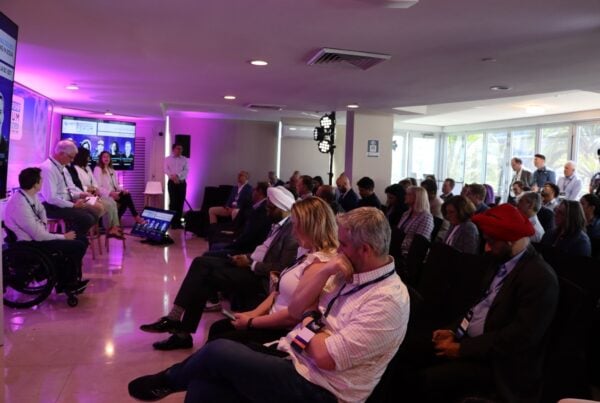Following the publication of a new MEF whitepaper on the topic, Andrew Parkin-White, MEF Advisor on IoT, discussed key issues on market development in IoT global connectivity with an expert panel. Here the panel tackle some of your questions from the discussion that were left unanswered.
The webinar on 3rd December 2020 raised some questions from attendees for the panellists. With limited time available, we were unable to cover these questions adequately during the session. Our panellists have responded with detail; we are grateful to the following individuals for the robust replies:
- Amy Garcia, Group Director of Marketing – Pod Group
- Ben Banister, Director Mobility and IoT Services – Tata Communications
- Stuart Mitchell, Chief Evangelist and Head of Product – ZARIOT
Question: When looking to buy an IoT platform, how do I determine which combination of network communications and IoT systems to use for a warehouse type application, for example? What are the questions I need to ask myself and the vendors to make the most informed decision?
Tata Communications: Questions you need to ask yourself are about what you want to achieve with the project? Just saying you want your business to become more efficient is probably not specific enough, so need a thorough examination of the quantitative improvements that are required. This in turn provides an idea as to the type of data and information you need to derive from the project. From this, flows what sort of data and with what frequency it needs to be generated. Finally, from this, you get some idea of the type of connectivity you will need – from relatively low data transmissions rates with low throughput all the way to low latency with high throughput requirements.
The next step is to think about the physical environment and whether lots of cabling can be installed or whether you want to have a flexible layout etc. You might need something as simple as a Wi-Fi based solution, with a very simple information management platform, or if your warehouse is complex and requires robotic picking systems, automated packing, multiple transport bays to manage etc, then it may require something more complex, possibly up to a private-LTE (pLTE) type set-up.
Pod Group: To add to the above, specific questions you might ask to determine whether you need to consider private-LTE are:
- Are there security or data protection concerns?
- Does the application require connectivity for mobile as well as static devices?
- Is there a need for the devices to be deployed in a dynamic configuration (i.e. does the physical location of the devices need to be flexible?)
- Are there applications that need to roam out of the factory premises and onto a macro network (e.g. tracking devices for goods entering or leaving the warehouse)
- Do devices need to be connected in both outdoor and indoor environments?
- Is the location of the warehouse in a remote area?
- Do specific policies need to be applied to different groups of devices (e.g. security policies)
If the answer is yes to any of the above a pLTE network may be the best approach.
Connectivity is the link between devices and storage/processing/analytics and – much like Internet access – while it can appear a mere commodity, it is important to find a provider that offers the right connectivity choices“
ZARIOT: As well as echoing the above comments with respect to pLTE and Wi-Fi or other unlicensed technologies there does not seem to be any particular linkage or a single provider of end-to-end connectivity and IoT platform at present. While that might be frustrating to potential clients it is, perhaps understandable.
Connectivity is the link between devices and storage/processing/analytics and – much like Internet access – while it can appear a mere commodity, it is important to find a provider that offers the right connectivity choices (2G, 3G, 4G, LTE-M, NB-IoT), future-proofed capability (e.g. eSIM) and value-added services (control portal, APIs, security protection) etc.
More often than not, specialist “system integrators” pull together all the necessary components to provide a full end-to-end solution for customers.
Question: What points of differentiation exist for providers of connectivity? Or is IoT connectivity necessarily commoditised from start to finish? Please explain your opinion.
Tata Communications: As per above response, the connectivity requirement is dependent on the type of project/application being considered. The first point of differentiation could be, does the provider cover every option (Cellular, Wi-Fi, Bluetooth, LoRa, Sigfox etc) – the answer to which in most cases will be ‘No’. Usually different companies will tend to specialise on different connectivity options.
The second question is what sort of additional services does the provider deliver beyond connectivity and possibly the third question to ask is does this provider seem to specialise in the area that I work in. So, taking the warehouse example, does the provider show evidence of having done this sort of work with other warehousing business and applications?
Pod Group: Adding to the first point above from Tata Communications, a provider can differentiate by giving customers access to a wide variety of different networks and types of IoT connectivity (as per those mentioned previously) and enable the user to manage and bill them via one interface in which they can be combined with value added services (e.g. advanced security, analytics or diagnostics). Differentiation is usually dependent on what level of integration the service provider has with each network or technology type and how much control and visibility they can offer the end user.
ZARIOT: Echoing comments above – every connectivity provider has its own niche (low-cost, upfront vs. monthly payment, focus on security, alliance with devices, back-end connectivity to public cloud) etc. Not every provider uses the same host MNO and therefore there are variations in coverage too which need to be considered when looking at less mature markets.
Question: What role will edge data centres (EDCs) play in IoT platform deployment? Is there a clear future for EDCs? Are we close to having them truly deployed overall? In the cityscape?
Tata Communications: As there is a big debate about mobile and network edge computing in general, then inevitably edge data centres become part of the debate. The move towards mobile edge computing is also tied to some of the trends associated with 5G. Assuming more information processing (with 5G) and assuming this information is expected to take place at the edge of the network, to improve latency. If this trend develops then yes edge data centres will contribute towards lower latency data processing closer to the applications that are generating the data and closer to the users who are accessing the data. This maybe an intuitive outcome for local deployments, however for global IoT deployments this is not quite the same, so this results in the need to still be able to breakout traffic via regional IP gateways and distribute this traffic via regional points of presence to/from applications in the cloud, as is currently the case.
ZARIOT: the question is where and when any edge devices offer benefit over backhaul to cloud. The main two reasons to deploy edge devices are to reduce latency (to provide faster “decision making”) and/or to reduce cellular backhaul to limit cost. Smarter devices tend to reduce the usefulness of lower bandwidth consumption and pLTE will address most latency issues.
Question: What is the role that Network slicing which is expected to come available in 5G, play in IoT? What is the reality of that? What timing are we looking at?
Tata Communications: The complexity associated with network slicing was debated a little bit on the webinar. As with so many technical concept – great idea from the perspective of being able to provide more customised end-to-end QoS, but difficult to implement and manage. It is very much dependent on the ubiquitous availability of 5G, which will take a long time to achieve pervasive coverage (if ever). 5+ years is a reasonable scenario, with longer in several countries.
Pod Group: However in a pLTE network, the ability to slice the network is already available today. LTE allows multiple logical networks to run on top of a shared physical network infrastructure and it enables connectivity to be customized to match the performance requirements of different applications and use cases. Within a pLTE network, the network can be sliced into different gateways. Segregating traffic allows for varying QoS for high/low bandwidth requirements and management of different security policies and network configurations. It also allows for “device quarantine” if there is a security threat, infected devices can be moved to a separate gateway to mitigate risk.
ZARIOT: while initially bullish about network slicing, like many others it is difficult to imagine it being technically possible to provide any kind of QoS with a network slice and therefore any perceived benefits are likely to be minimal. The control available from pLTE is a far more powerful solution.
Question: What could be done to achieve local pricing for connectivity in the IoT market especially in the emerging markets?
Tata Communications: Local SIM prices and tariffs can be provided by local network operators (in the case of cellular). For non-local providers who are focussing on global connectivity propositions, it is about getting as many local access agreements in place as possible. This provides options to roam between networks based on various combinations of parameters including cost, quality, availability etc. The availability of eSIM profile switching might be an interesting way to do this, with multiple profiles held on a single eSIM.
Pod Group: If local IMSIs are available we would agree that eSIM would be the ideal way to manage this . The advantage of eSIM is that it allows combinations of local profiles to be customised to achieve the best rates.
ZARIOT: Ultimately local pricing is in the hands of MNOs and their roaming partners. The sweet-spot of high-level of coverage combined with market-appropriate pricing is a given in Western Europe, but not readily available in many other markets (such as Africa) – where mobile operator groups dominate and steering is prevalent for consumer roaming. eSIM and multi-IMSI technology is only as good as the agreements it can bring.
The Future Of Global IoT Connectivity
In conjunction with its members, MEF has undertaken research into the current position and evolution of the market for global IoT connectivity.
The focus of the research is to explore key issues and questions around the development of the global mobile IoT connectivity ecosystem.
Download now






